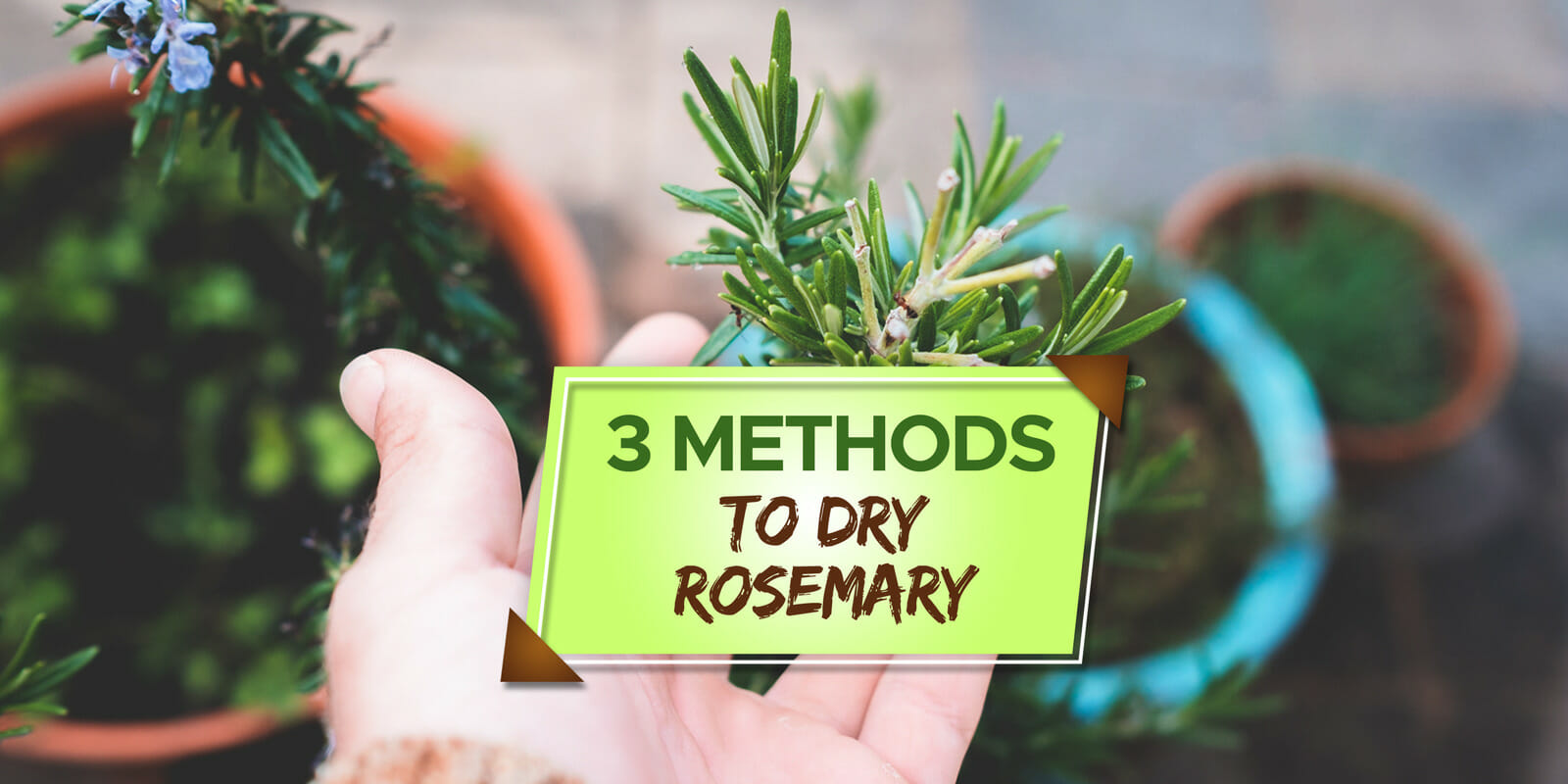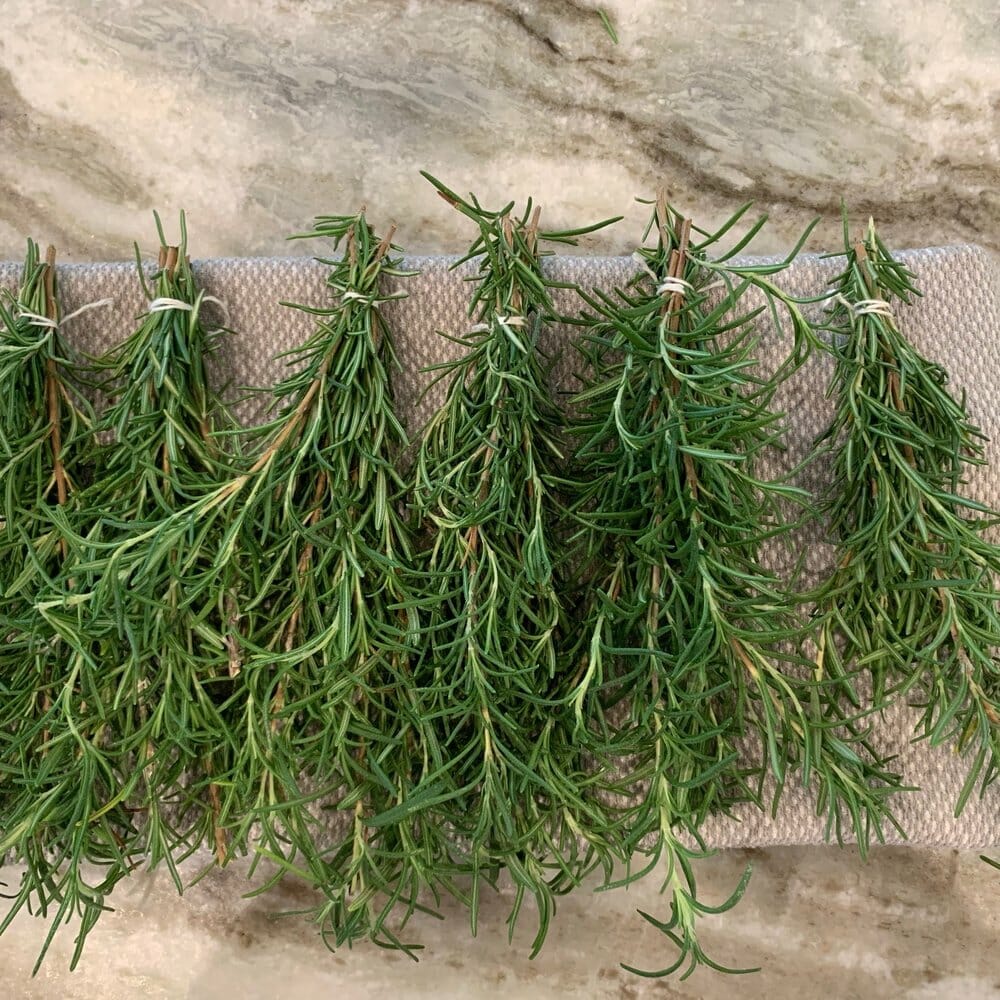
Who doesn’t love the smell of fresh rosemary growing in your garden? It’s incredible!
This fragrant herb grows so abundantly that, when it comes to harvest time, you will find yourself with more rosemary than you know what to do with.
The solution to this is drying, but how do you dry rosemary?
So, how to dry rosemary? Rosemary can be dried in several ways, but my favorite way is to air dry it in bundles, the traditional way.
Food preservation techniques like drying have been around for thousands of years since our ancestors gathered wild herbs, which still holds true to this day. Getting a handle on a technique like this will help you get the most out of your garden without wasting any of your harvests.
In this article, we are going to get rosemary a little bit better and give you tips on how to dry it to perfection.
What is Rosemary?
Yes, we may have eaten rosemary before, but what is it on a plant level?
Since we are all plant nerds here, let’s look at the specs:
| Specifications | |
| Family | Lamiaceae |
| Species | Salvia rosemarinus |
| Climate | Warm and mildly humid |
| Light | Full sun |
| Soil | Slightly acidic to neutral, well-draining |
| Life Span | 30 years |
Rosemary is a wildly popular herb that grows in small shrubs. They have needle-like leaves and bloom in the summer with pink, purple, and white flowers. It is native to the Mediterranean, which is why it flourishes in warm climates.
These beautiful bushes are attractive and imbibe the garden with their herbaceous fragrance.
Rosemary has a number of uses; it is a delicious ingredient to cook with, but it is also used for its scent in beauty products, home scents, and even cleaning products. The oil is also popular to burn on an oil burner to scent your home.

How to Dry Rosemary
So, your rosemary has been growing strong, and now it’s harvesting time!
There are a few things to keep in mind when harvesting:
- Harvest young stems for the best flavor
- Clip off whole stems using gardening shears rather than stripping the leaves
- Only harvest ⅓ of the plant at a time and leave for it to grow back between harvests
- The best time to harvest is late morning when the dew has fully dried
Due to how fast rosemary grows, there’s no way you can use all your fresh rosemary fast enough; that’s where drying comes in.
Drying is an age-old technique that has been used to preserve ingredients for thousands of years. Using this technique at home is better than buying dried rosemary because it will cost you less and be fresher and more favorable.
The main aim of drying rosemary well is to retain and preserve the color and flavor.
Rosemary can be dried in a number of ways:
1. Air Dry
The number one way to dry your rosemary at home is airdrying.
Yes, this may take a long time, but it will give you the best results, and it costs you no money in electricity.
Airdrying can be done using racks or hanging them in bundles.
Rack drying is faster but tends to take up more room. Simply lay the rosemary sprigs on a rack and leave them in a warm place out of direct sunlight. This method will take two to three days.
The more traditional way to air dry is by hanging them in bunches. To do this, divide your rosemary into small bundles and tie them together at the base with string. Hang these bundles upside down in your kitchen away from direct sunlight. Drying will take up to two weeks.
In our opinion, the bundle method is the best because it not only works well, but it looks beautifully rustic and will add a wonderful aroma to your space.
2. Oven Dry
If you are impatient and need your rosemary dried more quickly, we suggest using an oven but approach with caution! Overheating can lead to a bitter flavor and possibly even burn the leaves.
To oven dry, strip the leaves from the stems and spread them evenly on parchment paper on an oven rack. Heat the oven to its lowest temperature and place the racks inside, leaving the door slightly ajar. This will take two to four hours.
3. Food Dehydrator
If you have access to one, a food dehydrator is a really nifty way to dry out your herbs.
Strip the leaves from the stems, set the dehydrator to its lowest setting, and place the rosemary leaves inside in an even layer. This process will take six to eight hours. The low and slow technique helps to retain the color and flavor while working significantly faster than air drying.

Storing Your Dried Rosemary
So, now you’ve dried your rosemary, you need to know how to store it. Proper storage is key to prolonging the shelf life of any dried herb.
We suggest stripping the leaves off the stems and transferring them to an airtight jar or a Ziploc bag. Be sure to label the container with the date to know when it has passed its best.
Store the container in a cool, dark cupboard or pantry away from heat or direct sunlight, as these will degrade the herb more quickly.
If you store your dried rosemary correctly, it should last up to a year. After this date, it will not be harmful to consume, but the flavor will be significantly depreciated.
Frequently Asked Questions
Do you need to bring rosemary inside in winter?
Although rosemary is an evergreen, perennial shrub, it does not like cold climates.
If you live in an area with rather harsh winters, we suggest growing your rosemary in a pot and bringing it inside during the winter, so it doesn’t get killed by the frost or snow.
Can you freeze rosemary?
If you have a lot of rosemary on your hands, it is possible to freeze it to prolong its shelf life.
Once you have dried your rosemary using one of the methods we discussed, you can place the whole springs of rosemary, with the stems, into a Ziploc bag and squeeze out any excess air before freezing.
This should keep in the freezer for up to 2 years.
Should you let rosemary flower?
Although flowering spells the death of many herb plants, rosemary is not one of those herbs.
The rosemary flowers are not only beautiful, but they are also edible! While letting the flowers grow might limit the growth slightly, they will not affect the flavor of the leaves. Aside from their beauty, leaving the flowers to bloom will encourage bees to visit, which is essential for their pollination.
Conclusion
Growing rosemary is a gratifying pastime that will make your garden and your kitchen smell absolutely heavenly! The best way to harness this intense flavor and scent is by drying it.
In summation, we suggest air drying rosemary if possible. It is the cheapest option and preserves the flavor and color best. However, oven drying or using a dehydrator are good options.
We wish you plentiful harvests and sweetly scented dishes!


